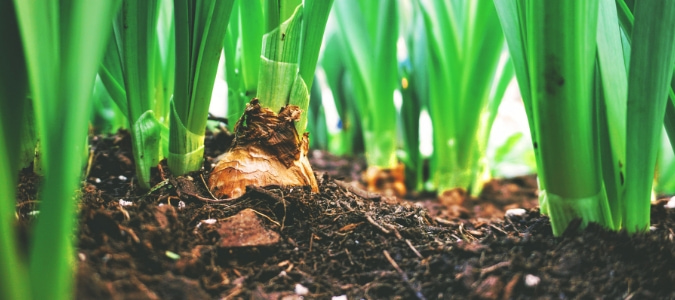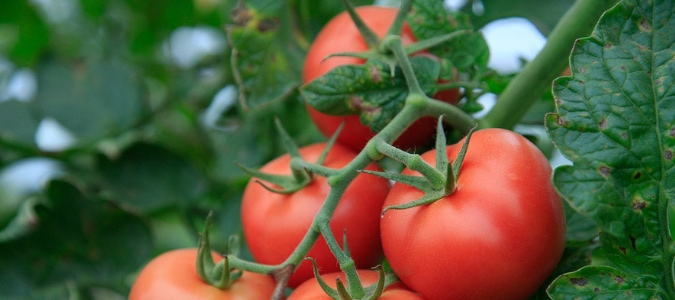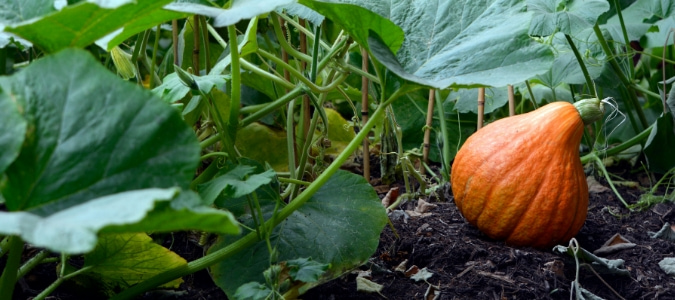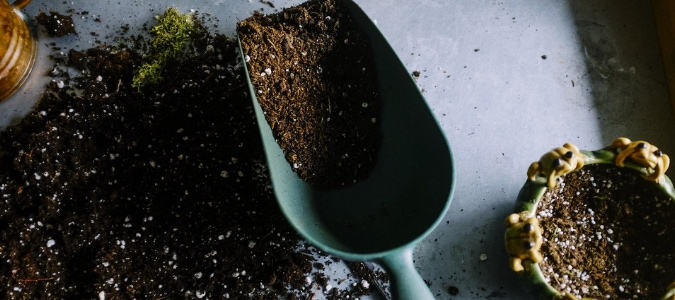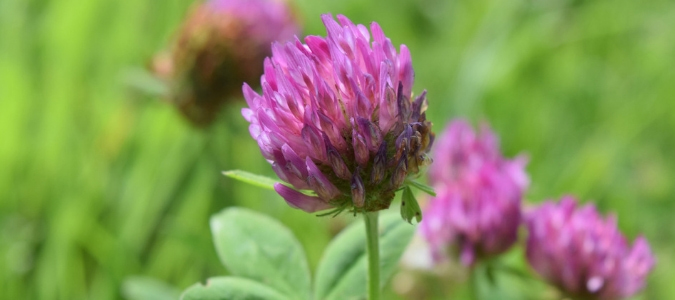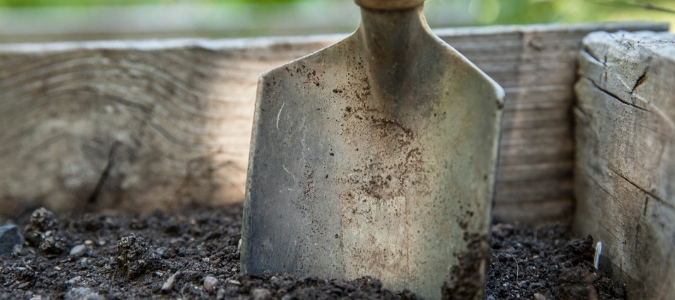
What do cow manure, grass clippings, dead leaves, coffee grounds and dinner scraps have in common? All of the above can be used to create or feed a compost pile, which you can then use in your garden to help keep your trees, plants, vegetable crops and soil healthy and thriving. Planting with compost is easy, as long as you know what you’re doing. Ready to learn everything you need to know about how to make and use compost in your garden? You came to the right place!
First, let’s talk about what compost is and what it’s used for. At its most basic, compost is simply partially decomposed organic matter—in other words, plant and other material that is nutrient-rich because it’s in the process of breaking down. Gardeners use compost to add important nutrients and microbes to the soil, in order to build its structure and help plants thrive. If you live in an area that has clay-like soil consistency, for example, compost can improve your dirt in by loosening it up. This helps water drain off more efficiently and makes the soil better suited for growing plants. If your area has sandy soil, on the other hand, compost can improve it by helping it retain water better. The right kind and amount of compost can also help reduce diseases and pests, and may also reduce the need for fertilizer.
Manure-based composts tend to have higher amounts of phosphorous, while plant-based compost—the kind you create when you toss kitchen scraps along with yard clippings into a pile of dirt in the corner of your garden—tends to be higher in nitrogen. That’s good for your garden; most home garden plots don’t want as much phosphorous as manure will provide. There isn’t much risk of excess nitrogen in soil, since it can easily be washed away by rain or converted into air. Phosphorous, on the other hand, moves through soil much more slowly, which means excess levels of this nutrient can really build up, making plants more vulnerable to pests and disease.
When deciding what types of compost to use in your yard, practical considerations may also enter the equation. Perhaps you start composting oak leaves simply to take advantage of how many fall into your yard when your trees shed their leaves. You may realize that you don’t have the time or the space to dedicate to turning these materials into rich soil. On the other hand, putting your kitchen scraps into a container outside may get you better (and quicker) results.
Let’s say you have moved beyond this stage and have an endless supply of compost and are not quite sure how to best use it. Now, you can explore the best ways to use compost to derive the most benefit for your plants and yard.
Planting In Compost Without Soil: Savvy Or Short-Sighted?
Most people see brown stuff on the ground outside and think of it as dirt, no matter what it might actually be composed of. That’s actually an error in thinking: Though they’re both brown and crumbly, compost is definitely not the same thing as dirt, and it’s certainly not a stand-in for soil. Certain types and compositions of compost can be appropriate for planting without soil, but you have to check the nutrient composition and consider the particular needs of what you plan to add into your yard or garden before making that decision.
In general, compost is a beneficial addition to most types of soil, whether your goal is to grow vegetables, flowers or other ornamental plants, but the compost should be only a small proportion of the “dirt” you’re planting in. This is because, with compost, a little goes a long way. Too much can create problems, especially if you’re using a manure-based variety. Using plant-based compost is best for most home gardening needs. A general rule of thumb is to spread just an inch or two per year on your garden beds, or up to three inches on a vegetable plot (since vegetables undergo regular harvesting, which removes more nutrients from the soil).
Growing Tomatoes In Compost: Can It Work?
Though compost is typically a better addition to soil than an alternative to it, there can be exceptions to that rule (“can” being the keyword here). Tomatoes are one crop that has been known to grow rather well in pure compost. Many home gardeners have reported volunteer tomato plants that reared up out of their compost piles after tomatoes with seeds were tossed into the pile. Instead of simply becoming part of the compost, as intended, the seeds germinated and grew into plants.
Growing tomatoes in compost on purpose may not be a good idea, however, unless you’re simply wanting to experiment, and you don’t mind if your plants end up weak, non-producing or even dying. Many varieties of tomato plants grow to be quite tall, and they need external support even in regular soil. Tomatoes grown in pure compost are almost certain to need stakes, cages or some other type of scaffolding since compost has such a crumbly, almost fluffy consistency as compared to the density of regular soil. Plants that grow tall or develop deep-reaching root structures, or both, just aren’t well suited for compost-only planting, since they’re likely to fall over as they mature.
Growing Vegetables In Pure Compost: Crazy Or Inspired?
Again, as a general rule, growing vegetables in pure compost isn’t a good idea except purely as an experiment (since sometimes it can work out!). Most plants simply need more structure, water retention and nutrients than compost alone can provide. There are certain crops, however, that can do well when planted in pure compost.
Along with tomatoes, as discussed above, pumpkins and squash are two other crops that can do well growing in pure compost. Squash plants are more sprawling than tall, growing close to the ground along vines, and they need well-draining soil. Both of these factors make them better suited for growing in pure compost than many other crop varieties. If you decide to grow pumpkins, squash or other crops in this way, be sure to water often, since pure compost can dry out too quickly for many types of plants.
Can I Use Compost Instead Of Soil?
As we’ve explored above, under a few scenarios it is possible to use compost instead of soil in planting, but it’s generally not advisable. Another reason that pure compost often isn’t conducive to growing plants is that it gets too hot internally, as the organic matter comprising it breaks down over time. Any plant that grows well in compost is going to be one that tolerates heat well, doesn’t grow too tall or heavy and thrives in well-draining soil.
If you do plan to plant anything in pure compost without adding any other soil, it’s a good idea to have your compost tested to measure its nutrient ratios and pH level. The optimal pH level for growing most vegetables is between 6.0 and 7.0; you can check levels yourself with a handheld pH meter to see if your compost might be suitable.
If you’re going to use compost instead of soil, you should also make sure to use only fully processed compost. This means it should be black and crumbly with a sweet, rich, earthy scent. Compost that contains identifiable food scraps or that has an acidic smell to it isn’t fully processed yet, and should not be used for planting.
Planting Compost Crops
Certain plants make great “compost crops”—plants a gardener grows specifically to help build a highly nutrient-dense and beneficial compost pile. This organic gardening method is often called “biodynamic gardening,” and its focus is on creating a superior compost from the start. If you want to try this method, you can devote any portion of your garden to compost crops that make sense for your space and your gardening needs.
Alfalfa and red clover make good compost crops, as both these plants will contribute beneficial minerals to your compost pile. You can plant either of these along the perimeter of your garden or in between rows of plants, and toss their clippings into your compost pile over time. Yellow clover is another good option that will contribute nitrogen not only to your compost pile but also to the soil where its roots are growing. Just be sure to plant yellow clover out of the way, as it could over-shade other nearby plants as it grows to its full height.
Comfrey and borage are two good herbs for compost crops, as they add zinc and phosphorous to the soil and to your compost pile via clippings. They also attract butterflies and bees. If you’re looking for a good compost crop for overwintering your garden, try winter rye. If you plant it in late fall or at the end of your garden’s harvesting season, it will protect the soil through the winter from cold, ice and snow, and add nutrients to the soil until spring, when it’s time to plant again. At that point, you can mow down the rye and compost the clippings, or simply till the soil thoroughly to make it ready for your new crops.
ABC Can Help With All Your Gardening and Landscape Needs
Gardening can be a fun, relaxing way to add beauty to your landscape along with fresh and nutritious food to your table, and composting plays an important role in any type of home garden. But if the idea of building a compost pile or Central Texas gardening challenges in general seem too daunting, ABC Home & Commercial Services can help. Remember, we’re just a phone call away. Our landscape and gardening experts will be happy to shoulder the labor of building and maintaining the garden of your dreams, so you can simply relax and enjoy its beauty and bounty.
